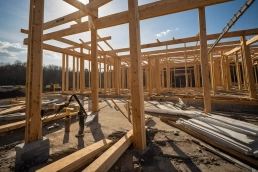Understanding Fire Spread in Timber Frame Structures
Timber is paving the way to more sustainable building practices. The production of cement accounts for 10% of carbon emissions worldwide, thus embracing alternative building materials, such as timber, can make an actual difference to mankind’s carbon footprint. Naysayers will claim that steel infrastructure is safer as fire spreads more rapidly in timber frame structures, however this simply isn’t the case.
To determine whether or not timber frame buildings are more at risk than their cement counterparts, we must first understand what makes a building effective in resisting fires. Structural adequacy, integrity are essential to guarantee proper resistance but what is equally important is the building’s insulation.
Insulation in timber frame structures
The insulation criterion evaluates a barrier’s effectiveness in containing a fire and preventing it from spreading beyond the room of origin. To satisfy this criterion, the temperature on the non-fire side of the barrier must not rise more than an average of 140°C or exceed a local maximum of 180°C.
What many people may not know is that timber can be “self-insulating”. In the event a fire breaks out inside a timber frame structure, the big planks of wood would char on the outside impeding the fire from spreading. As a matter of fact, according to studies steel and concrete buildings can suffer much more than timber frame structures. This is because steel melts at high temperatures causing the structure to collapse, on the other hand, concrete buildings are bizarre, as high temperatures can create “explosive spalling” – caused by particle violently breaking-off of the concrete layers due a build-up of water-vapour pressure.

Timber frame structures, however, manage to maintain structural stability because of their “self-insulating” ability. According to the website Timber Unlimited, in many instances, the char layer doesn’t burn away because the flames near the surface lack sufficient oxygen for the char to oxidise. As the fire decays and oxygen levels rise, the char can undergo oxidation, leading to smouldering combustion and some continued erosion of the char thickness. The heated wood beneath the char layer is approximately 35 mm thick, while the inner core stays at ambient temperatures.

Ensuring these structures get built
However, according to the HSE, the biggest threat to timber frame structures are fires that may occur during early phases of development. As a matter of fact, it is estimated that 11 construction fires occur every day. Not only do these incidents put lives and projects at risk, but they also result in a loss of around £400 million pounds a year.
This is precisely the reason why safeguarding construction sites is crucial. Thanks to groundbreaking technology developed by Ramtech, comprehensive fire coverage can be installed and managed easily and effectively by project managers. Ramtech’s WES3 is a fully customisable, temporary wireless system designed to offer a simple, fast, and secure way to communicate fire and medical emergencies in the challenging conditions of construction sites.
WES3 is even more powerful when paired with Ramtech’s REACT platform. This cloud-based solution delivers real-time alerts directly to those who need to respond. With 24/7 monitoring and notifications sent through an easy-to-use mobile app, information is instantly transmitted via the cloud, enabling rapid response. The system is adaptable to any site worldwide where emergencies may occur.
The Future's Looking Bright
As more countries explore ways to reduce their carbon footprint, it’s important to debunk the misconception that timber frame structures are at higher risk of burning down. In fact, these buildings can possess “self-insulating” properties, making it more difficult for fire to spread. Additionally, with innovative technology like Ramtech’s WES3 and REACT systems, timber projects can proceed safely without incidents, even when sites are left unattended.
Ramtech’s fire protection solutions have been trusted on major projects such as the Olympics Aqua Center, Arboretum, Landsec Net Zero Timber Square, and numerous timber developments across the U.S. These projects stand as a testament to the safety and sustainability that modern timber construction offers.